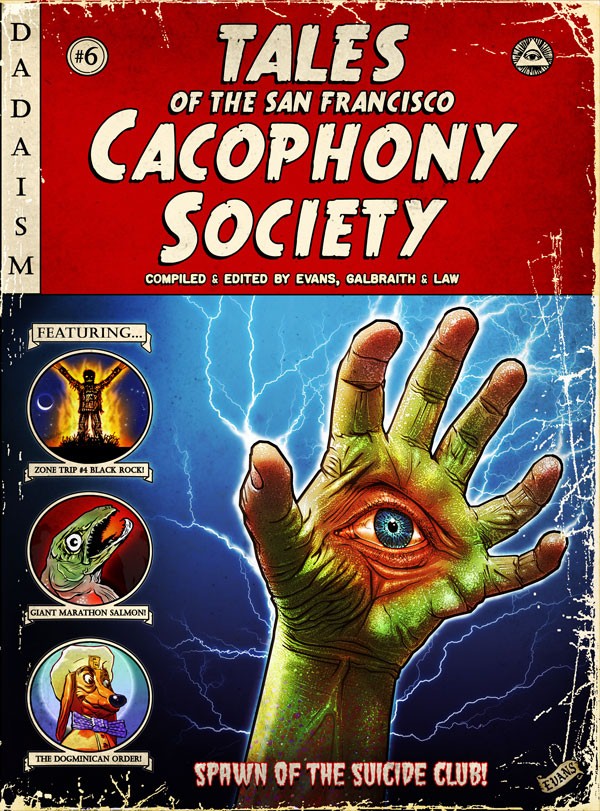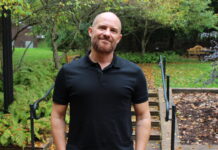When children do things like recoil in fear from monsters and ghosts in their darkened bedroom at night, it’s easy to see the “out of touch with reality” aspect of their experience as being closely related to the faculty that gives them their ability to play – their imagination. We help children through such challenging experiences by being with them, and by playing together, doing things like creating scary images together and then figuring out how to cope with them or laugh at them. In the process we help them explore how to create a world view that works to at least some extent and has room for joy and originality – when their imagination helps them (and maybe others) see the world in new ways.
In contrast, when adults see or believe in things others don’t, when they “go mad,” the situation is usually taken very “seriously,” and play is not seen as either part of the problem or as part of the solution. Either the person is seen as having biological defects, or they are seen as simply a victim of distressing life events. Either way, there is a sense we need to “take seriously” what is happening, and playing with it seems completely inappropriate. But does an exclusive focus on seriousness really allow us to understand what is happening, and does it really work best in helping people recover?
Within popular culture, the notion that there is something positive about madness, at least up to a point, can be seen reflected in some very common ways that words related to madness are used. For example, while an “insane” party can mean something bad it can also mean something very good; being “psychotic” can be a bad thing but it can also mean being “out there” in a good way for example related to creativity or spirituality.
Curiously, those convinced that the best way to reduce “stigma” is to portray madness as an “illness like any other” see it as part of their job to suppress any notion that there can be something fun about madness. For example, a NAMI page on stigma reduction contains the following paragraph:
Another triumph came in the field of advertising. Nestle’s line of Tasty, Tangy Taffy Bars featured wrappers bearing distorted cartoon faces of characters with names like “Psycho Sam,””Loony Jerry” and “Weird Wally.” Two alerts and even a letter from former First Lady Rosalynn Carter convinced Nestle to repackage the candies, minus the stigmatizing names and cartoons.
Of course, if madness is not an “illness like any other,” if it is more of a human thing, very multifaceted and containing potential for growth and change as well as hazards, then it might be a good thing to notice the fun side of madness; to notice not just the dangers, but also how it might be sometimes be liberating or even just amusing.
When people talk about madness this way, they are often accused of “romanticizing madness.” But the establishment usually doesn’t stop to notice that when they only look at the negative side of madness, they end up “awfulizing it,” and they amplify the fear of madness, which in turn increases distress and psychological problems. It seems time for a more balanced view, where we actively discuss and explore the positive sides of madness as well as the problems. This could help people put their own “mad” internal states into perspective, and also help enrich our culture by drawing on the positive side of these experiences and sharing them with others.
My own interest in this point of view is strongly influenced by the story of a close friend of mine, John Law. As a 17 year old, John experienced what psychiatry would call a “psychotic episode,” and was hospitalized, forcibly drugged and also restrained after attacking the television and then later assaulting a staff person who tried to preach religion to him. With such a start, he might easily have become a lifetime mental patient, but he was fortunate in that his parents pushed to have him released despite lack of improvement in the hospital. Once home, he was able to recover enough over a few months to then set out hitchhiking around the country, eventually landing in the San Francisco Bay Area where he met up with me (we knew each other previously.)
From a mental health professional’s perspective, at that point in time John would still have been seen as partly “ill” – he remained somewhat paranoid in his thinking, and he showed questionable judgment at times – for example, he invited randomly met street people to live for free in his first apartment, resulting in what was many ways a chaotic disaster. Still, no one died (even though a couple of the “residents” threatened to kill me during a brief period in which I stayed there) and it became an opening and educational round in what was to become for John a very interesting “adult” life.
John and I later shared a different apartment together, minus the street people (and also almost completely minus any furniture). This gave me an opportunity to have lots of in depth conversations with him about the positive side of madness (already an interest of mine) and about various paranoid ideas about the world, which we were learning to have fun with rather than “suffer from.” We felt we had ideas not many others shared, but we saw potential in our unique perspectives. Some months into this, he and I discovered the just forming San Francisco Suicide Club, and suddenly we both had strong social support in challenging everything “normal,” and in playing with lots of boundaries, including the boundary between madness and play.
While I enjoyed the Suicide Club, and even led a couple events (more on one of them below), John truly caught fire with it. When the Suicide Club faded away, probably due to its being too secretive, it was replaced by another, more public group, the Cacophony Society, and John quickly became one of its most prominent members and leaders. The “mad” fun he and his friends began having in turn drew in many others, and the rest is history.
That history is now told in a just released book, Tales of the San Francisco Cacophony Society, co-edited by John. As the promotional material says, “From Fight Club to Burning Man, Flash Mobs to Santarchy, cacophony influenced everything subversive, playful and anti-authoritarian in popular culture over the last 20 years – this is the great, untold story of the 1980s and ’90s.”
A little more about the book, Tales of the San Francisco Cacophony Society:
Before the Internet vomited headlines by the millisecond and turned the minutia of a million boring Facebook lives into news, we were left the privilege of mystery.
This was something The San Francisco Cacophony Society gave me in spades. Over the years, I would catch glimpses, collect pieces of a puzzle I was slowly assembling—a car crushed flat by an earthquake miraculously tooling down Golden Gate, toasters glued to buildings, news-clips of mock protests and costumed impostors, flyers for strange art spectacles.
Now the puzzle is assembled in this gorgeous graphic collection, a book every lover of eccentricity and enemy of the status quo should enjoy.
—Margaret Cho
If interested, you can find out more about Cacophony, see videos of various weird events, or order the book at http://talesofsfcacophony.com/
Madness and Questioning Socially Accepted Meanings:
As humans, we constantly are “making up meaning” for things, a meaning we later take for granted as social groups settle on similar agreed meanings. Accepted meanings can be helpful in some ways, but they can also be oppressive, especially to abuse survivors who had life-crushing meanings imposed upon them, or to free spirits who crave the openness that can be created when established meanings collapse. When a single person questions established meanings, that person is easily labeled as “mentally ill” and it’s easy for the establishment to assert that the person’s alternative experiences of meaning are themselves meaningless. But when a number of people question the accepted meanings together, then the arbitrary nature of limited forms of meaning, and the vast potential for alternative meanings, can be revealed in a way that is harder to deny.
Labor day weekend, 1990, 80 Cacophony members literally drew a line in the sand, a line they decided meant the boundary between normality and a “zone” they would create together. They then stepped across this line in unison, crossing over into a world that they created, a world that would become the first Burning Man in the Black Rock Desert in Nevada. The meanings they created there had resonance, and these days upwards of 50,000 people gather each year to experience a “mad” play space (though with the size came way too many rules for some!)
I believe lots of what happens within what we call “psychosis” could best be understood as being related to play and experimentation with alternative meanings, only typically it is play that is not conscious of itself being play. An example is the story of MIA blogger Rufus May. While he faced a certain amount of distress in his life, ranging from family arguments to a lost girlfriend and a boring job, it seems hard to explain his madness simply as an inevitable reaction to overwhelming distress. Instead, the madness seemed to emerge out of a dynamic where his mind played with ways of escaping the boredom and of rebuilding his identity, such as by seeing himself as a spy, though at the time he didn’t allow himself to be or wasn’t able to be conscious of the extent to which he was “just playing.” The result was getting dragged into the mental health system by force, but fortunately it was not a permanent stay.
When mainstream ways of making sense of things don’t work for us anymore, we naturally start experimenting or playing with other possibilities. Sometimes this tendency can be seen collectively; the Cacophony Society is just a modern form of this, and itself was influenced by earlier forms, such as Dadaism, which emerged in the art world after World War 1. Dadaists rejected the common sense of the day which they saw as a cause of the horrors of the war, and preferred instead artistic expression that appeared to reject logic and embrace chaos and irrationality. Productions were playful yet often meant to be offensive, as in Cologne’s Early Spring Exhibition which was “set up in a pub, and required that participants walk past urinals while being read lewd poetry by a woman in a communion dress.” Dada was easily characterized by outsiders as being “insane”, with one reviewer writing that “”Dada philosophy is the sickest, most paralyzing and most destructive thing that has ever originated from the brain of man.” (Quotes are from the Wikipedia article on Dada.)
Can movements like Dada, carried out by people who are conscious of their playfulness and who are deliberately defying the bounds of “normality” help us understand people who aren’t so conscious of what they are doing? Could we really provide better mental health care if we helped people transition from “psychotic” states where they might be caught up in imagination and play without enough awareness that it is play, to more deliberately playful and/or artistic exploration? I am convinced that the answer is yes, partly because of my own experience, about which I have written elsewhere, and partly because of what I’ve seen in other people’s stories, John Law’s experience of course being just one of them. I think “peer support” for people seen as “mad” can go beyond just trying to help them recover and return to “normality” – it can also include helping them find what is both extraordinary and possibly helpful or fun in their experience, and helping them learn positive ways of sharing that with others.
The social toleration of madness and play:
I don’t think it is just a coincidence that the Suicide Club and the Cacophony Society arose in the same geographical area as did the great mental health alternatives of the 70’s, such as Soteria, Diabasis, and I Ward. Rather, I think a social climate in the San Francisco Bay Area that tolerated and even enjoyed eccentricity and benign “madness” contributed to both movements. One early figure who illustrates this point was Emperor Norton, a San Francisco man who in the mid 1800’s declared himself emperor of the United States, and who was so appreciated by the citizens of San Francisco that they allowed him to pay his bills in a currency he himself invented. A later example was Frank Chu, a man who showed up a huge variety of venues carrying picket signs complaining about how he had been exploited by a nefarious network of alien populations he identified as the “12 Galaxies.” Frank became sufficiently well known that a local restaurant adopted the name “12 Galaxies” and then proceeded to honor Frank for his contribution by providing him free food and drink. Emperor Norton was an early hero of the Suicide Club, and both Norton and Chu were inspirational figures for Cacophony.
Another interesting example was Kent Robertson ben Abraham, best known for his graffiti campaign “Gravity is the Fourth Dimension” which he used to spread awareness about his reinterpretation of Einstein’s theory of General Relativity, explained in his book “The New Gravity.” This book became a top seller in some stores, though it wasn’t clear how many people took the ideas seriously versus how many simply found the concepts eccentric and fun. Kent himself was sure that physics and even society could be revolutionized by his theory which replaced the notion that gravity consisted of things falling to earth, with the idea that objects remained suspended in space while the earth expanded outward along the fourth dimension and struck them. I should explain that at the time I as well took these ideas very seriously (here’s my explanation of these ideas from that time period.) I was in turn both tolerated and found entertaining by others, who for example invited me to present my perspective at a well attended meeting at the Gorilla Grotto.
Being listened to, even if not necessarily believed, helped me think through my own ideas, sorting out what made sense and what didn’t (I still think some of Kent’s ideas had value, even if I can now see flaws in much of what I believed at the time.) In his book “How The Hippies Saved Physics; Science, Counterculture, and the Quantum Revival” MIT professor David Kaiser recorded how the same tolerant, playful SF Bay Area culture that I enjoyed supported both “crazy” approaches within physics and also ideas that became eventually groundbreaking within the mainstream. We really can’t support creativity within a society without also having a more tolerant and playful approach to “mad” perspectives of many kinds, partly because it isn’t always clear at first what will be really helpful versus what is “just crazy.”
A little more about a Suicide Club event I led, the Merry Mouth Mental Health Tour:
This “tour” was also my first foray into mental health activism: it was a “mad pride” event of sorts. Its intention was to allow people to play with how they might act in the world if they didn’t feel pressured to convey an impression that they were “sane.” Put another way, it was designed to challenge the inhibiting effect of the fear of how one will be treated if one is seen as “insane,” it challenged the “mental health oppression” that is part of our daily lives.
The way the event was structured was simple: our group divided into people who would be “mental patients” and those of us who would be “mental health professionals.” We then set out on a tour of downtown San Francisco. “Patients” could act as strangely as they wanted, but if any member of the public seemed too offended or concerned, the “professionals” would gently redirect them or escort them away. Since “professionals” seemed to be in control, we figured we wouldn’t have to worry about anyone causing too much trouble for our “patients,” and that proved to work out well.
As the organizer, I played the role of one of a professional, wearing a white shirt with an engraved nametag that said “Dr. Vectricity, Pataphysician.” (This was my commonly used alter-ego at the time, for reasons that would make another story.) The “patient” that I escorted had brought with him a “camera” obviously made of cardboard, and entertained himself by asking tourists to pose for pictures. Watching the “normals” trying to decide how to make sense of what was happening as my “patient” experimented with becoming increasingly bizarre in the way he related to them was definitely interesting. Whenever someone seemed too annoyed, I had my “patient” move on. I don’t think any of us bothered anyone too badly, but I did notice that when our entire group got on a cable car, almost everyone else got off at the next stop.
In a way, our “mental health tour” modeled what people do in a healthy mental health system – letting people explore “madness” in a safe way, hanging in close with the “mad” person to help them both avoid being hurt by others who don’t understand the process and also to keep them from hurting any others or themselves. That’s what happened in places like Soteria. I saw something similar when participating in an indigenous spiritual ritual that induced altered states of consciousness: the idea was that people were vulnerable when they opened up to the spirits (which themselves could be good or bad) but that by having one’s community circling around especially when intense experiences were occurring, bad spirits could be warded off, good spirits could be made to interact more gently, and gifts might come to the community through the altered states and visions of those who were in a sense temporarily “mad.”
Currently, those who are involved in the cultural fringes related to either creativity or spirituality are usually unlikely to be involved in any kind of mental health activism, or to identify what they are doing as being related to “mad pride.” In fact, people involved in such fringe movements may resist any effort to see a connection with “madness,” seeing any such connection as a threat to their credibility. This is true even though it is common for many people in “fringe” communities to have at times “gone over the edge” and been forced at least for a time into psychiatric treatment.
I look forward to the day when the link between cultural fringes and “mad” experience can be seen as both obvious and also as not undermining the credibility of those fringe movements, because by then the value of having at least some people “go out of their minds” and way outside what is socially normal, will be understood and appreciated, and plenty of people will be aware of ways to help people do that with better safety and more rewarding results.
Meanwhile, have fun, and create some “madness” of your own…..in a good way!
















Wonderful post, and you bring out a very important, but overlooked healing strategy – Madness should not be taken too seriously. How I wish doctors had cracked a smile or made a few jokes when my son was first hospitalized. Oh, no, instead, madness is VERY SERIOUS business indeed, and that attitude strikes horror in the hearts of patients and relatives alike. I bet my son would have taken a shorter time to get back on his feet if we all hadn’t been encouraged to be so damn serious about THE PROBLEM. You are absolutely right about the self-appointed stigma busters: “But the establishment usually doesn’t stop to notice that when they only look at the negative side of madness, they end up “awfulizing it,” and they amplify the fear of madness, which in turn increases distress and psychological problems.”
Report comment
Thanks Rossa. Obviously, there are some potentially very serious sides to madness – getting lost in it can lead to death or lifetime disability – but in order to notice that, we don’t have to blind ourselves to the other sides of it. I think we do best when we take a complex view, seeing the risks but also the other sides, such as the way it might contribute to development, or how it illuminates the uncertainty we all face as we attempt to make sense of a world that itself is at least partly mad.
Report comment
Very interesting post. Have you read any of Juli McGruder’s work on schizophrenia in Africa? Her theory is that the reason WHO finds better outcomes in those cultures is because they see this dualist model whereby insanity brings both challenges and blessings (and the solution is often appeasing the spirits rather than forcefully removing them).
Of course, try explaining that to a Western mental health professional and you just get an ‘I see’ and a note in your file that you have ‘diminished insight’ leading you to be ‘treatment noncompliant.’ And having humor towards them? That is called ‘inappropriate affect’. :-p
Report comment
Thanks for the reference to Juli McGruder’s work. The notion of madness as involving both “challenges and blessings” is certainly more balanced than most of our “mental health treatment.” Unfortunately, when the mental health system is unbalanced, it contributes to problems for the person, but then any additional problems created are just seen as “part of the person’s illness” rather than as the fault of the system.
Report comment
Ron, very inspiring post.
Report comment